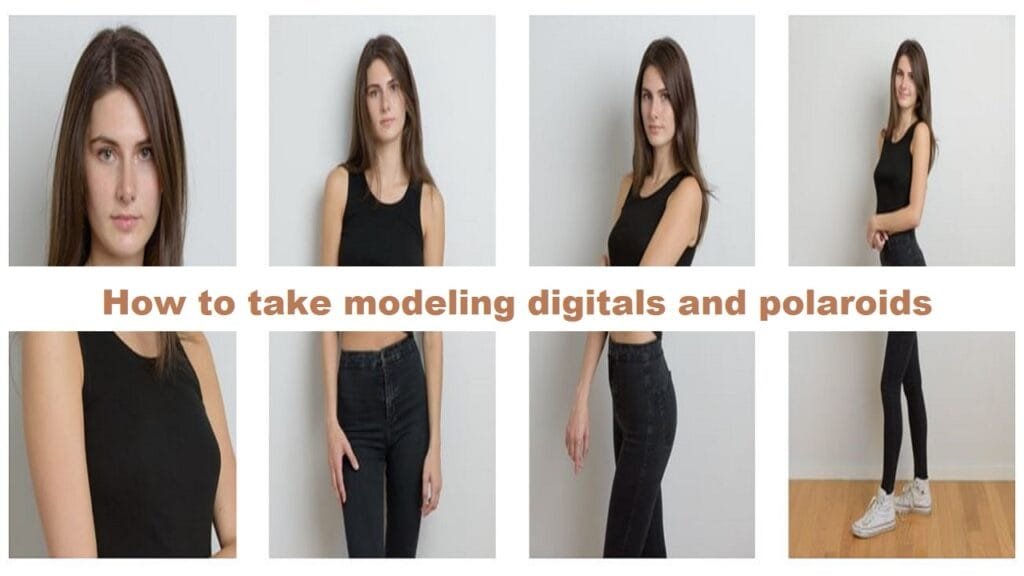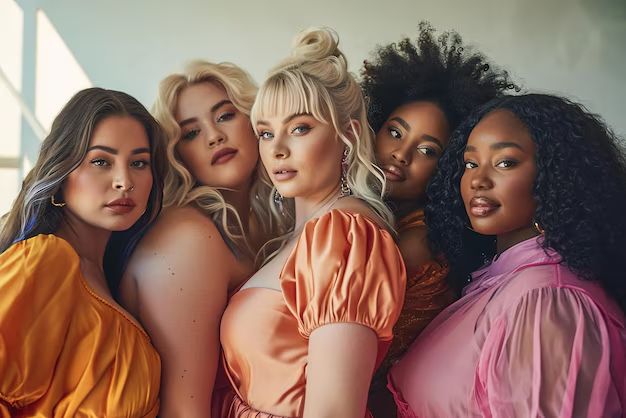You’ve likely heard of modeling digitals or “model digitals” (a.k.a., the crucial first impression).
They’re raw, unedited photos that capture you exactly as you are – no filters, no makeup, no retouching. Think of them as the anti-Instagram pics. They’re as natural as you can get and a standard expectation for anyone looking to get noticed by modeling agencies.
Digitals for modeling are serious business. The more polished and professional, the more doors they can open.
Read Also: How to make a stand-out model comp card
What Exactly Are Modeling Digitals (and Polaroids)?
So, what are modeling digitals? Sometimes called model Polaroids, they’re basically mug shots but in the best way possible.
Modeling digitals are your honest self on display – showcasing your face, body, and features as they are in real life, stripped of all the extras.
Digitals are meant to show clients and agencies what they’ll get when you walk through the door, without any surprises or distractions. No fancy makeup, no editing, no strategic angles to hide anything. Just you, exactly as you are.
Originally, these images were taken with actual Polaroid cameras. Now, while we use digital cameras instead, the name has stuck.
When I was starting out, I thought my first set of modeling digitals would be the easy part. “How hard could it be to look natural?” I thought. But I quickly realized that looking good without any help from makeup or lighting tricks is a skill in itself.
Agencies want to see the unfiltered you, so learning to embrace it is key.
Why Are Modeling Digitals Essential?
Imagine you’re an agency scouting for the next big name, and all you’ve got are heavily edited, perfectly styled photos. Not helpful, right?
Modeling digitals is a smart way to track changes. I mean, things like hair color, hair length, new tattoos, or even changes in body type – these can all influence what gigs you’ll book, and agencies need to know about them. That’s why many agencies will ask for fresh model digitals every three months or so.
In my experience, agencies also find digitals more practical to update than headshots or comp cards, which can be pricey and time-consuming.
This way, they’re always ready to send your latest look to clients, no matter what changes you’ve gone through.
In short, Keeping up-to-date digitals for modeling in rotation means you’re ready to show your true self at a moment’s notice, helping you land that next opportunity.
How Often Do You Need to Update Your Model Digitals?
In most cases, agencies recommend updating your model digitals every few months – three to be exact – or whenever you make a significant change.
Personally, I’d say it’s not just a good idea but essential. I’ve seen models miss out on gigs because their digitals for modeling didn’t reflect a new haircut or color change, so staying up-to-date is a must.
Should Modeling Digitals Be Part of Your Portfolio?
The short answer? Yes, but separately. Your modeling digitals are absolutely worth featuring on your professional site, but they shouldn’t mix with your portfolio photos.
Agencies like to see the contrast between your raw images and your stylized shots, so keeping them separate is smart. Even on social media, model digitals can be a fantastic way to showcase your natural look for casting agents and clients browsing online.
Why Hiring a Pro for Modeling Digitals Makes a Difference
You can technically take your own modeling digitals, but if you’re serious about modeling, a professional photographer is worth every penny.
Here’s the deal: experienced photographers know how to use lighting, angles, and a natural background to capture model digitals that pop while staying true to you.
While agencies might accept iPhone snaps, let’s be real – the difference in quality between a professional setup and a quick phone pic is night and day.
A pro photographer also understands the requirements agencies are looking for, giving you an edge in making those model agency digitals look polished yet natural. Many aspiring models don’t realize that good modeling digitals can sometimes land you agency attention before a full portfolio even does.
Taking Your Own Modeling Digitals (If You Must)

For those of you going the DIY route, here are a few tips.
- First, go for natural lighting – usually, early morning or late afternoon is best;
- Find a plain white wall and set your camera (or phone) at about shoulder height;
- Keep your hair down (unless instructed otherwise);
- Wear simple form-fitting clothes;
- keep your posture strong but relaxed; and
- Your expression should be neutral to friendly, and try to avoid any strong posing.
I’ll be honest: even though I’m discussing how to model digitals, taking your own can be tricky. Selfies or tripod shots can work, but you have to get the lighting and angles just right, which is where a photographer’s trained eye comes in.
How To Pose For Modeling Digitals
When it comes to getting those perfect modeling digitals, it’s all about angles, expressions, and showing a bit of personality while staying professional.
Trust me, a little attention to detail here can make a huge difference in your shots. Here are four things you should do to make sure you’re putting out the best version of yourself.
1) Get All Angles and Distances
Model digitals are usually taken at three distances: full body, 3/4 shots, and headshots.
You’ll want a good mix of angles at each of these distances to give agencies a well-rounded view of your look. That means doing full frontals, diagonal shots, and profile shots.
I remember the first time I did a digital session – I thought I’d just stand straight and smile. Then the photographer started asking for specific angles, and I realized how much thought actually goes into each shot.
2) Minimal Posing
With modeling digitals, less is more. Keep your hands at your sides and look directly at the camera, which works well for most angles.
You can switch it up a bit for forward shots, maybe giving a slight shoulder angle or a natural hand position, but avoid overdoing it. It’s not about dramatic poses; the goal is to show agencies the real, unfiltered you.
3) Expressions
Agencies don’t want a flat stare – they want to see a range of expressions that show your versatility.
Play around with subtle smiles, serious looks, or confident gazes. Think of it as showing your “model face,” which can still be natural yet convey something a little extra. Don’t be afraid to give a little attitude or emotion.
I’d recommend practicing in front of a mirror to get a feel for your “natural look.” It can be helpful to take some practice shots with your phone to see what reads well on camera.
If you’re ever stuck, there are tons of online tutorials on how to pose for digitals to get that natural, model-ready look.
4) Follow Directions
If your photographer gives you specific directions, follow them to the letter. This is a skill in itself – being able to take direction well is essential in modeling.
I once had a photographer tell me to adjust my head by just a fraction, and wow, the shot completely transformed. Trust your photographer’s eye; they know how to bring out your best.
What Should You Wear For Modeling Digitals?
When it comes to wardrobe, the rule is minimalism. This is not the time for trendy or flashy outfits. Agencies need to see you clearly without any distractions. Here’s a solid checklist:
- Form-fitting jeans and a plain T-shirt
- Neutral colors like black, white, or gray
- Clothing without patterns or logos
- Plain swimsuit (optional but often requested)
Comfort is key here too; the last thing you want is to be distracted by a tight waistband or slipping straps. I made the mistake of wearing a shirt with a small logo once, and, needless to say, I had to retake the photos.
Hair and Makeup For Modeling Digitals
For modeling digitals, less is more. Most agencies prefer minimal to no makeup, allowing your natural features to shine through. Just stick to these basics:
- Hair: Keep it natural. Either down, tucked behind your ears, or in a simple ponytail. No elaborate hairstyles needed.
- Makeup: Very light, if any. Agencies might allow a bit of cover-up for blemishes or a dab of lip gloss, but that’s it.
When I started, I felt a little self-conscious about my bare face in front of the camera. But after a few shoots, I got comfortable and realized the agencies love seeing a raw, natural look.
After Your Modeling Digitals
Once you’ve wrapped up your session, the next step is submitting those shots to modeling or talent agencies.
Research agencies, look for their online submission guidelines, and start sending your digitals their way. Many agencies accept digital submissions through their websites, which makes it super convenient to reach out.
Posting these images on social media can also be a great way to kickstart your career. Tag agencies or use industry hashtags to get noticed.
That first step might feel daunting, but building up your online presence can open doors you didn’t even know were there.
How to Book a Shoot For Modeling Digitals
Booking your modeling digitals shoot doesn’t have to be complicated. Here’s what I’d recommend:
- Research Photographers: Find someone who specializes in model digitals and has experience working with models.
- Discuss the Setup: They’ll need a white wall and natural or soft lighting to get that industry-standard look.
- Schedule a Pre-Shoot Call: Go over your expectations and clarify any details to make sure you’re both on the same page.
A well-planned shoot goes a long way in capturing clean, professional images. It makes all the difference.
Why Modeling Digitals Are Key to Your Success
Quality modeling digitals can make a huge impact on your career. They’re an essential part of your portfolio, allowing agencies and casting directors to see the real you without filters or heavy edits.
Having the perfect set of model digitals means you’re always prepared to showcase your look and land the gigs you’re after.
With these tips, you’re ready to book your session, put on that best natural look, and let those digitals work their magic.


![Guide to Creating a Stand-Out Modeling Portfolio [with Examples]](https://showbizpromotions.com/wp-content/uploads/2024/11/Guide-to-Creating-a-Stand-Out-Modeling-Portfolio-with-Examples.png)


